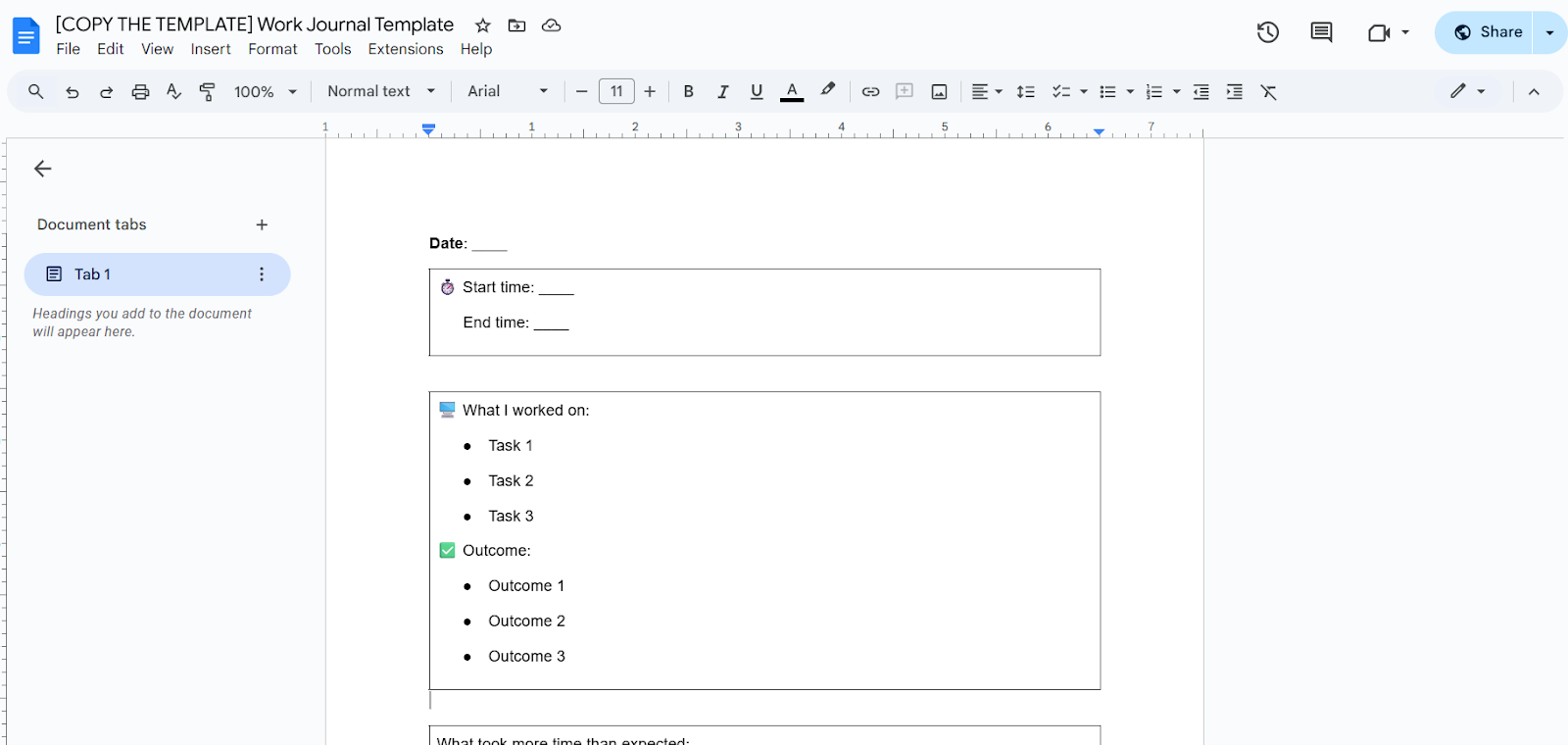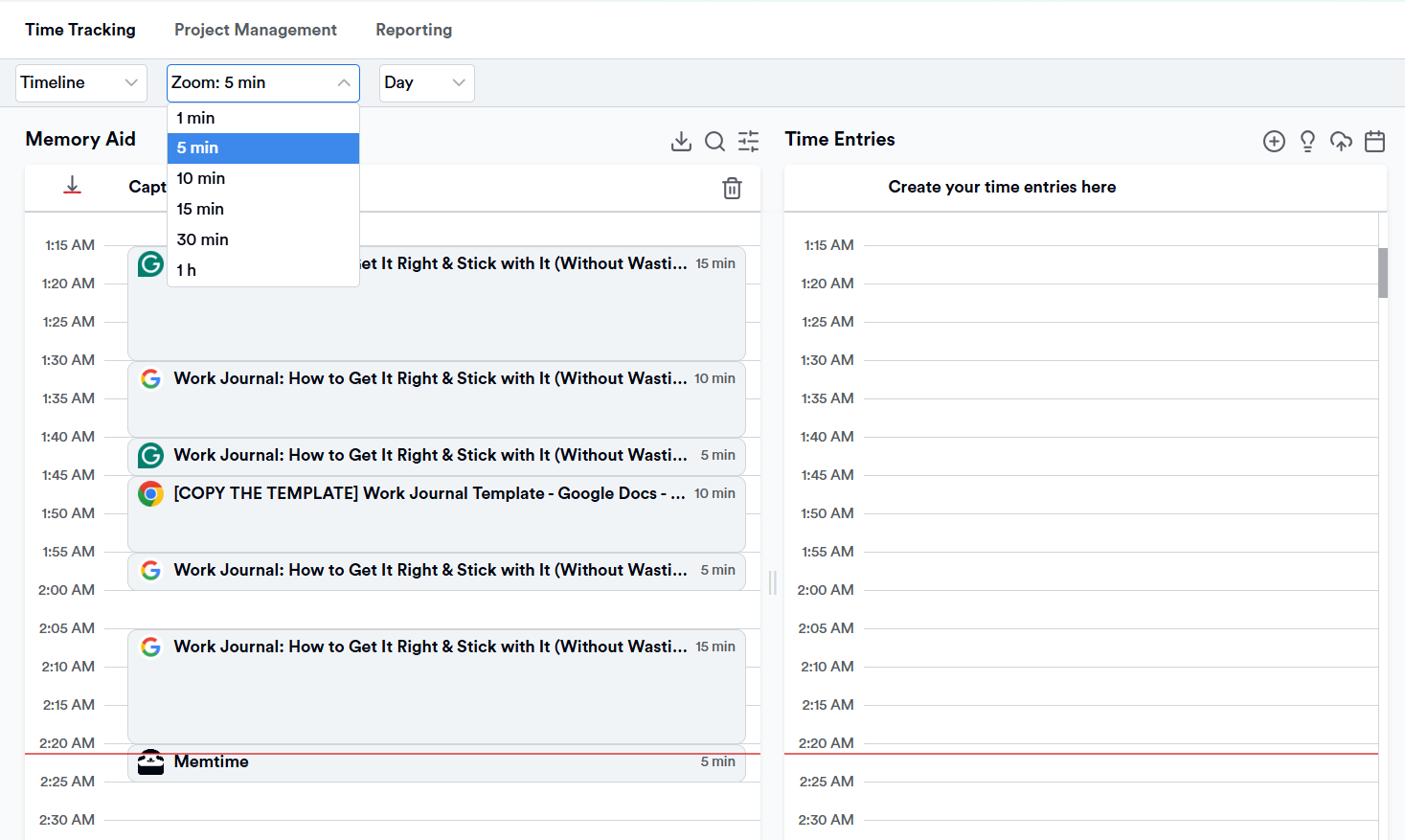Work Journal: How to Get It Right & Stick with It (Without Wasting Time)

You opened your laptop at 9 AM. You looked at the clock at 5 PM. And that’s the end of your workday.
But what the heck happened in the meantime?
If you are unsure, keeping a work journal might be a good idea for you.
I promise you, a work journal isn’t one of those productivity hacks. And it’s definitely not another to-do list in your endless list of to-dos. It can actually help.
Here’s everything you need to know about work journaling and how to do it right. Let’s roll.

Key Takeaways:
- A work journal helps you finally answer the “What did I even do today?” question with real details instead of guesswork.
- It’s more than a fancy productivity hack; it’s a way to boost focus, clarity, and honesty about how you actually spend your time.
- Your journal can take any shape: notebook, Google Doc, Notion page, template, whatever you’ll realistically stick with.
- Automatic tools like Memtime can write your work journal for you, giving you accurate, private, minute-by-minute insights with no effort.
- The secret to journaling that lasts? Keep it short, make it useful, review it regularly, and reward yourself for all the effort.
- When you log your work consistently, you spot patterns, cut the busywork, and finally make more time for the work that actually matters.
What is a work journal?
A work journal is the grown-up, corporate version of your teenage diary.
But instead of complaining about who didn’t text you back, you’re jotting down what you did, how you did it, for how long, and what tasks interrupted you along the way.
Basically, a work journal is a record of your workday. It’s a place where you track:
- What you worked on.
- When you worked on it.
- How long it took.
- What helped or derailed you.
- What you accomplished.
- What you want to improve (tomorrow).
Such a journal can be a notebook, a Google Doc, a Notion page, a spreadsheet, or anything else that you can call “a system”. Think of it as a part logbook, part progress tracker (or time tracker), and part personal performance dashboard. It’s your personal “what I did” log that helps you spot your working patterns and keeps you accountable.
If anything, it serves as a source of truth for your work life, giving you information on what you did and how you did it.
Why bother with a work journal?
Why do you need to journal about work when you have emails, Slack, and meetings as proof of work?
That’s a fair question.
Well, because a work journal isn’t just a diary for your emails, Slack threads, or lunch breaks. It’s primarily a tool for boosting performance and productivity. It can help you see yourself, your role, and work more objectively.
Here’s what I mean by that:
- A work journal can increase your productivity, as it gives you a clearer record of what you did, when you did it, and how long it took. It helps you see exactly how your time is being used, so you can eliminate inefficiencies and work more intentionally.
- It can improve focus and prioritization. When you write down your big goals, daily tasks, and what matters, you’re less likely to wander off. By keeping your priorities visible, you reduce decision fatigue and see what’s actually important.
- It gives you structure and clarity. When you track your tasks and progress, you get valuable data to improve your performance (and even get that promotion). Over time, this structure makes it easier to plan your days, identify patterns, and communicate your achievements.
- It helps you be less biased. Your memory is unreliable; you can “remember” you spent an hour on a project when, in reality, you only spent 30 minutes. A work journal provides evidence, helping you make better decisions based on facts and real data.

What does a work journal look like?
There’s no unified “look” of a work journal. It depends on the tools you want to use and how detailed you want it to be.
But let’s see how others do it. Here are some slightly paraphrased quotes from a Reddit thread in r/Journaling:
- I do a nightly entry: 3 things I achieved, 1 thing I messed up, 1 thing I’m going to improve tomorrow.
- I started tracking start time, stop time, what I worked on, and then I review weekly to see how many hours vanish in thin air.
- I just write, “Today I spent too much time on email”, and add a note to batch my email tomorrow.
All these work journal entries have several things in common:
- Tasks, like “Worked on client proposal”.
- Time, like “9:15 - 11:30” (or “approximately 2 hours, including interruptions”).
- Outcome, like “Draft sent to senior, waiting for feedback”.
- Reflection, like “Could’ve been faster if I didn’t respond to every Slack ping”.
- Action for tomorrow, like “Mute Slack until 10:30”.
So, if you want to build your own template, I suggest you include these fields:
- Date: ____
- Start time: ____
- End time: ____
- What I worked on: ____
- Outcome: ___
- What took more time than expected: ____
- What helped me focus: ____
- What pulled me off track: ____
- What I’ll do differently tomorrow: ____
If you don’t feel like contemplating what your work journal should look like, you can skip the DIY phase and steal our work journal template. No spreadsheets to design, no overthinking.

Is there a way to automate a work journal?
There is, and I’m so glad you asked. 🎉
You can track your work in many ways—using classic pen-and-paper journals, digital note taking apps, browser extensions, or dedicated productivity tools. But among all these options, automatic time tracking tools could be the most effective. They run quietly in the background, capturing what you work on and when, without you having to remember or manually log anything.
Why these tools specifically?
Because our human memory is unreliable. You think you started working on a task at a particular time, but you don’t know it for sure. Automatic tracking gives you objective and accurate data that you can use for your decision-making.
Memtime is one of those tools.
In fact, it’s more than just a tool. It can double as your private work journal—without the handwriting cramps and crumpled paper.
Memtime is our fully automatic time tracker, meaning it quietly records everything you work on throughout the day, including apps, files, browser tabs, you name it. All down to the minute. No timers to start, no reminders to click. It just… works in the background while you do your thing.

It's a completely private desktop app. All your activity data stays on your computer, locally, by default. Nothing gets uploaded to the cloud, and there’s no mobile app tracking your every move. Your workday stays your business unless you choose to export it, in which case you can seamlessly connect it to 100+ project management and billing tools.
Inside Memtime, you get a super detailed timeline of your day that you can scroll through like a personal log of everything you’ve touched. You can zoom in or out on the details, adjust how granular the timeline is, and use it to reconstruct your day with total accuracy.

All that so you can see your journaling entries, improve billing, or just finally know where your time goes.
And if you need actual reports? Memtime has you covered with historical insights, customizable reports, data exports, and integrations with hundreds of popular tools.
So if you want your work journal to basically write itself—100% privately, and in the background—Memtime is the tool for you.
Your future self will love you for this. Just click the button below to start your 2-week free trial. 👇
How to make work journaling stick
Work journaling is similar to exercising. You start all excited and pumped up, but by the third time you have to go to the gym, you’re thinking about every possible excuse to bail… like suddenly your houseplants need watering, your inbox is so “urgent,” and you simply must reorganize your sock drawer. 🙂
That’s why we compiled 5 key tips to help you actually stick with it, without wasting time.
Let’s go through them together.
#1 Pick a format you’ll actually use
If you hate handwriting, no fancy leather notebook is going to motivate you. Similarly, if you constantly jump between devices, a paper journal definitely won’t work either.
So, choose your medium carefully:
- Paper notebook, if you prefer tangible and slower journaling.
- Digital one if you want a searchable, quick, and accessible work journal.
- Hybrid, like something that you can scribble quickly, and transfer later.
#2 Set goals for journaling
Why do you want to journal? What’s the value here?
Do you want to track how long tasks take?
Spot when you’re procrastinating?
Or record wins so you can celebrate your success?
These are your new goals, your whys. When you know why you’re doing something, it’s easier to stick with it.
#3 Keep it short and sweet
The real value of your work journal entries is in the details. You can add just the recorded start time, end time, what you worked on, what broke you out of flow, and what helped you focus. Five entries are more than enough.
#4 Review regularly
Logging for the sake of logging is pointless; the gold is in reflection.
Make it a routine to review your journal entries, so you can assess progress and spot patterns. You can do so weekly or monthly, just make sure you do it continuously.
#5 Reward yourself
Celebrate the win of just doing it, like grabbing a chocolate chip cookie once you do 5 entries per week. Us humans respond to reward, even a small one. 🙂
Wrapping up
A work journal can be a powerful tool; it gives you insight into your own work habits. If you commit to logging what you do, how you spend your time, and what you’ll try differently, you give yourself a real shot at doing less busywork and more work that matters.
So, just start with it. Grab your notebook, or Memtime, and go. I promise you tomorrow will be slightly better if you start today.
Do I really need a work journal if I already have emails, Slack messages, and meetings?
Kind of, yes. Emails and Slack messages show what happened around you, not what you actually did. A work journal gives you the full picture of your day: what you worked on, how long it took, and what distracted you. Think of it as your personal “proof of effort” log that no inbox can replace.
What should I even write in a work journal?
Keep it simple. Write what you did, when you did it, how long it took, what tripped you up, and what you’ll try tomorrow. You’re not writing the next great novel—just capturing bits of your workday. The more honest you are, the more useful your journal becomes.
How long should a work journal entry take?
A few minutes, tops. You don’t need paragraphs, just the essentials that help you understand your day later. Short entries are easier to stick with and still give you good enough insights.
What if I forget to journal or fall off the wagon?
It happens to the best of us. The trick is simply getting back to it without guilt or drama. Review a few old entries, remind yourself why you started, and jump in again.
Can I automate my work journal so I don’t have to remember anything?
Absolutely! Automatic time tracking tools, like Memtime, capture your workday for you, including apps, tabs, and documents. They fill in the gaps your memory leaves behind and give you an accurate timeline. It’s like having a tiny assistant who never forgets anything (and never judges you).
How do I make work journaling a habit I don’t ditch in a week?
Pick a format you actually enjoy using and keep your entries short. Set tiny goals, review your notes regularly, and reward yourself for sticking with it. Make the process easy and fun, and it becomes a habit without feeling like homework.
Aleksandra Doknic
Aleksandra Doknic is a copywriter and content writer with six years of experience in B2B SaaS and e-commerce marketing. She's a startup enthusiast specializing in topics ranging from technology and gaming to business and finance. Outside of work, Aleksandra can be found walking barefoot in nature, baking muffins, or jotting down poems.






